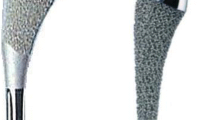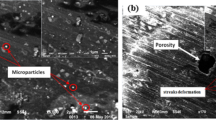Abstract
Damage accumulation in the cement mantle and debonding of the bone–cement interface are basic events that contribute to the long-term failure of cemented hip reconstructions. In this work, a numerical study with these two process coupled is presented. Previously uniform bone–cement interface mechanical properties were only considered. In this work, a new approach assuming nonuniform and random bone–cement interface mechanical properties was applied to investigate its effect on cement degradation. This methodology was also applied to simulate and compare the degradation process of the cement and bone–cement interface in three different concepts of design: Exeter, Charnley, and ABG II stems. Nonuniform and random mechanical properties of the bone–cement interface implied a simulation closer to reality. The predicted results showed that the cement deterioration and bone–cement interface debonding is different for each implant depending on the stem geometry. Lower cement deterioration was obtained for the Charnley stem and lower bone–cement interface debonding was predicted for the Exeter stem, while the highest deterioration (cement and bone–cement interface) was produced for the ABG II stem.







Similar content being viewed by others
References
Barrack, R. L., R. D. Mulroy, and W. H. Harris. Improved cementing techniques and femoral component loosening in young patients with hip arthroplasty: a 12-year radiographic review. J. Bone Joint. Surg. 74:385–389, 1992.
Bauer, T. W., and J. Schils. The pathology of total joint arthroplasty II. Mechanisms of implant failure. Skeletal Radiol. 28:483–497, 1999. doi:10.1007/s002560050552.
Bergmann, G., G. Deuretzbacher, M. Heller, F. Graichen, A. Rohlmann, J. Strauss, and G. N. Duda. Hip contact forces and gait patterns from routine activities. J. Biomech. 34:859–871, 2001. doi:10.1016/S0021-9290(01)00040-9.
Bishop, N. E., M. Schoenwald, P. Schultz, K. Püschel, and M. M. Morlock. The condition of the cement mantle in femoral hip prosthesis implantations—a post mortem retrieval study. Hip Int. 19(2):87–95, 2009.
Chwirut, D. J. Long-term compressive creep deformation and damage in acrylic bone cements. J. Biomed. Mater. Res. 18:25–37, 1984. doi:10.1002/jbm.820180105.
Clech, J. P., L. M. Keer, and J. L. Lewis. A model of tension and compression cracks with cohesive zone at a bone–cement interface. J. Biomech. Eng. 107:175–182, 1985.
Eisler, T., O. Svensson, V. Iyer, B. Wejkner, A. Schmalholz, H. Larsson, and E. Elmstedt. Revision total hip arthroplasty using third-generation cementing technique. J. Arthroplasty 15(8):974–980, 2000. doi:10.1054/arth.2000.9825.
Franklin, J., O. Robertsson, J. Gestsson, L. S. Lohmander, and T. Ingvarsson. Revision and complication rates in 654 Exeter total hip replacements, with a maximum follow-up of 20 years. BMC Muskuloskelet. Disord. 4(1):6, 2003. doi:10.1186/1471-2474-4-6.
García Araujo, C., J. Fernández González, and A. Tonino. Rheumatoid artritis and hydroxiapatite-coated hip prostheses: five-year results. International ABG Working Group. J. Arthroplasty 13(6):660–667, 1998. doi:10.1186/1471-2474-4-6.
García, J. M., M. Doblaré, and J. Cegoñino. Bone remodelling simulation: a tool for implant design. Comp. Mater. Sci. 25(1–2):100–114, 2002. doi:10.1016/S0020-1383(03)00076-7.
Grasa, J., M. A. Pérez, J. M. García-Aznar, J. A. Bea, and M. Doblaré. A probabilistic damage model for acrylic cements. Application to the life prediction of cemented hip implants. Int. J. Fat. 27:891–904, 2005. doi:10.1016/j.ijfatigue.2004.12.009.
Havelin, L. I., B. Espehaug, S. E. Vollset, and L. B. Engesaeter. The effect of the type of cement on early revision of Charnley total hip prostheses. A review of eight thousand five hundred and seventy-nine primary arthroplasties from the Norwegian Arthroplasty Register. J. Bone Joint Surg. Am. 77(10):1543–1550, 1995.
Heller, M. O., G. Bergmann, G. Deuretzbacher, L. Dürselen, M. Pohl, L. Claes, N. P. Hass, and G. N. Duda. Musculo-skeletal loading conditions at the hip during walking and stair climbing. J. Biomech. 34:883–893, 2001. doi:10.1016/S0021-9290(01)00039-2.
Hernigou, P., G. Daltro, C. H. Lachaniette, X. Roussignol, M. M. Mukasa, and A. Poignard. Fixation of the cemented stem: clinical relevance of the porosity and thickness of the cement mantle. Open Orthop. J. 3:8–13, 2009. doi:10.2174/1874325000903010008.
Horne, J. G., W. Bruce, P. A. Devane, and H. H. Teoh. The effect of different cement insertion techniques on the bone–cement interface. J. Arthroplasty 17(5):579–583, 2002. doi:10.1054/arth.2002.32695.
Huiskes, R., N. Verdonschot, and B. Nivbrant. Migration, stem shape, and surface finish in cemented total hip arthroplasty. Clin. Orthop. Rel. Res. 355:103–112, 1998. doi:10.1097/00003086-199810000-00011.
IGES Charnley hip stem: BiomedTown – The Biomedical Research Community, website: http://www.biomedtown.org/biomed_town/LHDL/Reception/datarepository/repositories/BelRepWikiPages/FrontPage, accessed in 2008.
Jasty, M., W. J. Maloney, C. R. Bragdon, D. O. O’Connor, T. Haire, and W. H. Harris. The initiation of failure in cemented femoral components of hip arthroplasties. J. Bone Joint. Surg. 73(4):551–558, 1991.
Kim, D. G., M. A. Miller, and K. A. Mann. Creep dominates tensile fatigue damage of the cement–bone interface. J. Orthop. Res. 22:633–640, 2004. doi:10.1016/j.orthres.2003.09.007.
Kim, D. G., M. A. Miller, and K. A. Mann. A fatigue damage model for the cement–bone interface. J. Biomech. 37:1505–1512, 2004. doi:10.1016/j.jbiomech.2004.01.011.
Lemaitre, J. A continuous damage mechanics model for ductile fracture. J. Eng. Mater. Technol. 107:83–89, 1985. doi:10.1115/1.3225775.
Lennon, A. B., B. A. McCormack, and P. J. Prendergast. The relationship between cement fatigue damage and implant surface finish in proximal femoral prostheses. Med. Eng. Phys. 25:833–841, 2004. doi:10.1016/S1350-4533(03)00120-6.
Lennon, A. B., and P. J. Prendergast. Residual stress due to curing can initiate damage in porous bone cement: experimental and theoretical evidence. J. Biomech. 35:311–321, 2002. doi:10.1016/S0021-9290(01)00216-0.
MacDonald, W., E. Swarts, and R. Beaver. Penetration and shear strength of cement–bone interfaces in vivo. Clin. Orthop. Relat. Res. 286:283–288, 1993.
Mann, K. A., D. C. Ayers, F. W. Werner, R. J. Nicoletta, and M. D. Fortino. Tensile strength of the cement–bone interface depends on the amount of bone interdigitated with PMMA cement. J. Biomech. 30:339–346, 1997. doi:10.1016/S0021-9290(96)00164-9.
Mann, K. A., D. L. Bartel, T. M. Wright, and A. H. Burstein. Coulomb frictional interfaces in modeling cemented total hip replacements: a more realistic model. J. Biomech. 28(9):1067–1078, 1995. doi:10.1016/0021-9290(94)00158-Z.
Mann, K. A., F. W. Werner, and D. C. Ayers. Modeling the tensile behavior of the cement–bone interface using nonlinear fracture mechanics. J. Biomech. Eng. 119:175–178, 1997. doi:10.1115/1.2796077.
Mann, K. A., and L. A. Damron. Predicting the failure response of cement–bone contructs using a non-linear fracture mechanics. J. Biomech. Eng. 124:462–470, 2002. doi:10.1115/1.1488167.
Mann, K. A., M. J. Allen, and D. C. Ayers. Pre-yield and post-yield shear behaviour of the cement–bone interface. J. Orthop. Res. 16:370–378, 1998. doi:10.1002/jor.1100160314.
Mann, K. A., R. Mocarski, L. A. Damron, M. J. Allen, and D. C. Ayers. Mixed-mode failure response of the cement–bone interface. J. Orthop. Res. 19:1153–1161, 2001. doi:10.1016/S0736-0266(01)00036-5.
Markolf, K. L., and H. C. Amstutz. In vitro measurement of bone-acrylic interface pressure during femroal components insertion. Clin. Orthop. 121:60, 1976.
Moreo, P., M. A. Pérez, J. M. García-Aznar, and M. Doblaré. Modelling the mixed-mode failure of cement–bone interfaces. Eng. Fract. Mech. 73:1379–1395, 2006. doi:10.1016/j.engfracmech.2006.01.005.
Morgan, R. L., D. F. Farrar, J. Rose, and H. Forster. Creep behaviour of bone cement: a method for time extrapolation using time-temperature equivalence. J. Mater. Sci. Mater. Med. 14:321–325, 2003. doi:10.1023/A:1022927814801.
Morlock, M., E. Schneider, A. Bluhm, M. Vollmer, G. Bergmann, V. Müller, and M. Honl. Duration and frequency of every day activities in total hip patients. J. Biomech. 34:873–881, 2001. doi:10.1016/S0021-9290(01)00035-5.
Murphy, B. P., and P. J. Prendergast. The relationship between stress, porosity, and nonlinear damage accumulation in acrylic bone cement. J. Biomed. Mater. Res. 59:646–654, 2002. doi:10.1002/jbm.10028.
Nelissen, R. G., E. H. Garling, and E. R. Valstar. Influence of cement viscosity and cement mantle thicknees on migration of the Exeter total hip prosthesis. J. Arthroplasty 20(4):521–528, 2005. doi:10.1016/j.arth.2004.09.036.
Ni, G. X., Y. S. Choy, W. W. Lu, A. H. W. Ngan, K. Y. Chiu, Z. Y. Li, B. Tang, and K. D. K. Luk. Nano-mechanics of bone and bioactive bone cement interfaces in load-bearing model. Biomaterials 27:1963–1970, 2006. doi:10.1016/j.biomaterials.2005.09.044.
Nuño, N., A. Madrala, and D. Plamondon. Measurement of transient and residual stresses during polymerization of bone cement for cemented hip implants. J. Biomech. 41(12):2605–2611, 2008. doi:10.1016/j.jbiomech.2008.06.030.
Oates, K. M., D. L. Barrera, W. N. Tucker, C. C. Chau, W. D. Bugbee, and F. R. Convery. In vivo effect of pressurization of polymethyl methacrylate bone–cement. Biomechanical and histologic analysis. J. Arthroplasty 10(3):373–381, 1995. doi:10.1016/S0883-5403(05)80188-3.
Pérez, M. A., J. Grasa, J. M. García-Aznar, J. A. Bea, and M. Doblaré. Probabilistic analysis of the influence of the bonding degree of the stem–cement interface in the performance of cemented hip prostheses. J. Biomech. 39:1859–1872, 2006. doi:10.1016/j.jbiomech.2005.05.025.
Pérez, M. A., J. M. García-Aznar, M. Doblaré, B. Seral, and F. Seral. A comparative FEA of the debonding process of cemented hip implants. Med. Eng. Phys. 28:525–533, 2005. doi:10.1016/j.medengphy.2005.09.007.
Pérez, M. A., J. M. García, and M. Doblaré. Analysis of the debonding of the stem–cement interface in intramedullary fixation using a non-linear fracture mechanics approach. Eng. Fract. Mech. 72(8):1125–1147, 2005. doi:10.1016/j.engfracmech.2004.09.002.
Pérez, M. A., J. M. García-Aznar, and M. Doblaré. Does increased bone–cement interface strength have negative consequences for bulk cement integrity? A finite element study. Ann. Biomed. Eng. 37(3):454–466, 2009. doi:10.1007/s10439-008-9616-7.
Pérez, M. A., N. Nuño, A. Madrala, J. M. García-Aznar, and M. Doblaré. Computational modelling of bone cement polymerization: temperature and residual stresses. Comput. Biol. Med. 39(9):751–759, 2009. doi:10.1016/j.compbiomed.2009.06.002.
Perez, M. A., P. Fornells, M. Doblaré, and J. M. García-Aznar. Comparative analysis of bone remodelling models with respect to computerised tomography-based finite element models of bone. Comput. Methods Biomech. Biomed. Eng. 13(1):71–80, 2010. doi:10.1080/10255840903045029.
Race, A., M. A. Miller, D. C. Ayers, and K. A. Mann. Early cement damage around a femoral stem is concentrated at the cement/bone interface. J. Biomech. 36:489–496, 2003. doi:10.1016/S0021-9290(02)00460-8.
Reading, A. D., A. W. McCaskie, M. R. Barnes, and P. J. Gregg. A comparison of 2 modern femoral cementing techniques. J. Arthroplasty. 15(4):479–487, 2000. doi:10.1054/arth.2000.5266.
Stolk, J., N. Verdonschot, and R. Huiskes. Stair climbing is more detrimental to the cement in hip replacement than walking. Clin. Orthop. Relat. Res. 405:294–305, 2002.
Stone, J. J., J. A. Rand, E. K. Chiu, J. J. Grabowski, and K. N. An. Cement viscosity affects the bone–cement interface in total hip arthroplasty. J. Orthop. Res. 14:834–837, 1996. doi:10.1002/jor.1100140523.
Sundfeldt, M., L. V. Carlsson, C. B. Johansson, P. Thomsen, and C. Gretzer. Aseptic loosening not only a question of wear: a review of different theories. Acta Orthop. 77(2):177–197, 2006. doi:10.180/17453670610045902.
Tong, J., K. Y. Wong, and C. Lupton. Determination of interfacial fracture toughness of bone–cement interface using sandwich Braxilian disks. Eng. Fract. Mech. 74:1904–1916, 2007. doi:10.1016/j.engfracmech.2006.02.014.
Venesmaa, P. K., H. P. Coger, J. S. Jurvelin, H. J. Miettinen, O. T. Suomalainen, and E. M. Alhava. Periprosthetic bone loss after cemented total hip arthroplasty: a prospective 5-year dual energy radiographic absorptiometry study of 15 patients. Acta Orthop. Scand. 74(1):31–36, 2003. doi:10.1080/00016470310013617.
Verdonschot, N., and R. Huiskes. Mechanical effects of stem cement interface characteristics in total hip replacement. Clin. Orthop. 329:326–336, 1996.
Verdonschot, N., and R. Huiskes. Subsidence of THA stems due to acrylic cement creep is extremely sensitive to interface friction. J. Biomech. 29(12):1569–1575, 1996. doi:10.1016/S0021-9290(96)80008-X.
Viceconti, M., R. Muccini, M. Bernakiewicz, M. Baleani, and L. Cristofolini. Large-sliding contact elements accurately predict levels of bone-implant micromotion relevant to osseointegration. J. Biomech. 33(12):1611–1618, 1996. doi:10.1016/S0021-9290(00)00140-8.
Wang, Y., P. Han, W. Gu, Z. Shi, D. Li, and C. Wang. Cement oscillation increases interlock strength at the cement–bone interface, with commentary. Orthopedics 32(5):325, 2009.
Willert, H. G., H. Bertram, and G. H. Buchhorn. Osteolysis in alloarthroplasty of the hip. The role of bone cement fragmentation. Clin. Orthop. 258:108–121, 1990.
Zhang, H., L. T. Brown, L. A. Blunt, and S. M. Barrans. Influence of femoral stem surface finish on the apparent static shear strength at the stem–cement interface. J. Mech. Behav. Biomed. Mater. 1:96–104, 2008. doi:10.1016/j.jmbbm.2007.06.001.
Acknowledgments
The authors gratefully acknowledge the research support of the Spanish Ministry of Science and Technology through the Research Project DPI2008-02335, the Institute Salud Carlos III (CIBER-BBN), and the Aragon Regional Government through the Research Project PI031/08.
Author information
Authors and Affiliations
Corresponding author
Additional information
Associate Editor Michael S. Detamore oversaw the review of this article.
Rights and permissions
About this article
Cite this article
Pérez, M.A., Palacios, J. Comparative Finite Element Analysis of the Debonding Process in Different Concepts of Cemented Hip Implants. Ann Biomed Eng 38, 2093–2106 (2010). https://doi.org/10.1007/s10439-010-9996-3
Received:
Accepted:
Published:
Issue Date:
DOI: https://doi.org/10.1007/s10439-010-9996-3




